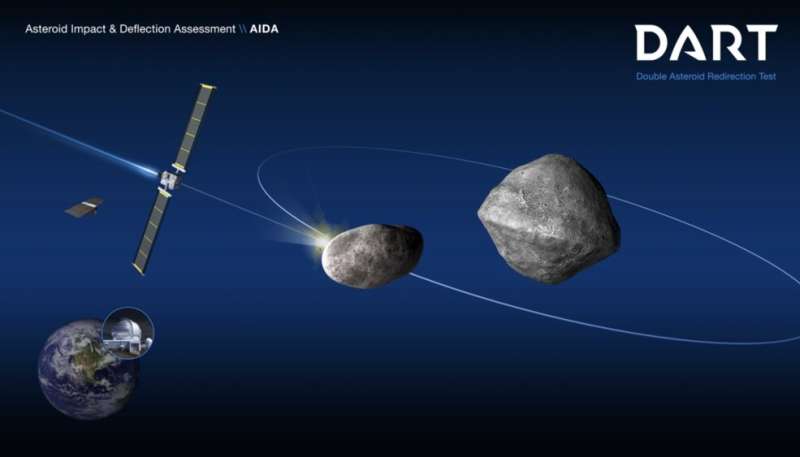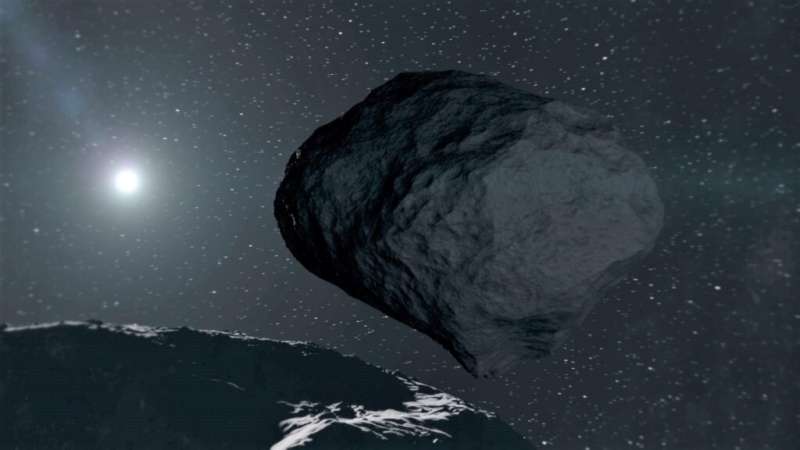Schematic of the DART mission shows the impact on the moonlet of asteroid (65803) Didymos. Post-impact observations from Earth-based optical telescopes and planetary radar would, in turn, measure the change in the moonlet’s orbit about the parent body. Credits: NASA/Johns Hopkins Applied Physics Lab
Surprising results from recent asteroid missions have highlighted the importance of testing planetary defence strategies in space, according to scientists participating in the joint ESA/NASA Asteroid Impact and Deflection Assessment (AIDA) collaboration. The unexpectedly large crater on asteroid Ryugu created by the JAXA Hayabysa2 impactor, together with the sand-like behaviour of material on its surface, further motivate the need to determine the effectiveness of proposed deflection techniques for an asteroid on a potential collision course with Earth. Implications are being discussed this week at the EPS-DPS Joint Meeting 2019 in Geneva.
The AIDA collaboration encompasses two missions that will demonstrate and evaluate the 'kinetic impactor' technique at the near-earth binary asteroid, Didymos. NASA's Double Asteroid Redirection Test (DART) will impact the smaller of the two companions, Didymos B, in September 2022. ESA's Hera mission, if funded at the Ministerial Conference in November this year, will rendezvous with the Didymos asteroid pair and investigate the outcome of the impact in 2027.
Didymos B – sometimes known as "Didymoon" – is around 160 metres in diameter and will be the smallest target object for a mission to date. Asteroids around 100-200 metres in size are the most common type of Near Earth Objects (NEOs) that could potentially end up on a collision course with Earth and cause regionally catastrophic devastation. However, it is thought that only about a third of these objects have been detected and tracked to date.
Dr Patrick Michel, who is presenting in sessions on planetary defence at EPSC-DPS 2019, said, "The impact with Hayabusa2 showed that there was no cohesion on the surface and the regolith behaved like pure sand. Gravity was dominating the process, rather than the intrinsic strength of the material from which the asteroid is made. If gravity is also dominant at Didymos B, even though it is much smaller, we could end up with a much bigger crater than our models and lab-based experiments to date have shown. Ultimately, very little is known about the behaviour of these small bodies during impacts and this could have big consequences for planetary defence."
The DART mission is on track to launch in July 2021. The DART spacecraft will impact Didymos B, with the aim of shortening the time it takes the moonlet to orbit its larger companion by several minutes. Telescopes on Earth will be able to observe Didymos both before and after DART's impact, and these observations will be used to measure the amount of deflection caused by DART's impact. The impact will be imaged by LICIACube (Light Italian Cubesat for Imaging Asteroids), a cubesat contributed by Agenzia Spaziale Italiana (ASI), which will be deployed from the DART spacecraft a few days prior to impact.
Nancy Chabot, DART Mission Coordination Lead and Planetary Scientist at Johns Hopkins University Applied Physics Laboratory, said: "DART's target, Didymos, is an ideal candidate for humankind's first planetary defence experiment. It is not on a path to collide with Earth, and therefore poses no current threat to the planet. However, its binary nature enables DART to trial and evaluate the effects of a kinetic impactor."
ESA’s Hera mission will visit the double asteroid Didymos. It will get close to the smaller of the two asteroids, Didymoon, an artistic rendering of which is shown in this image. Credit: ESA – Science Office
A primary objective of ESA's Hera mission is to measure the mass of Didymos B to estimate how efficient the kinetic impact turned out to be. It will study the impact crater in detail and characterise the physical and mineralogical properties of the asteroid pair.
An in-depth understanding of the Didymos binary pair provided by the Hera mission, together with ground-based observations, would enable planetary defence preparations to go to a new level of planning by scaling the effects of the impact to other asteroids.
Hera has passed its system requirements review, which demonstrates that the mission can proceed into development. Following a green light at the meeting in November, in addition to start building the spacecraft, the Hera team will plan the operations at the asteroid in detail.
Last week the AIDA Consortium held a workshop in Rome to show the status of DART, LICIACube and Hera. The meeting was attended by over 100 participants from 18 countries.
Michael Kuppers said, "DART and Hera will provide valuable knowledge individually. However, when combined together through the AIDA collaboration, the scientific and technical benefits are enhanced considerably. In an even wider context, comparing the physical properties of Didymos to those of Ryugu from JAXA's Hayabusa2 mission and the Bennu asteroid studies by NASA's OSIRIS-REx mission will significantly contribute to our understanding of how single and multiple asteroid systems form and evolve."
AIDA is the international ESA- and NASA-supported collaboration that will combine the data obtained from NASA's DART mission, ASI's LICIACube, and ESA's Hera mission to produce the most accurate knowledge possible from the first demonstration of an asteroid deflection technology. The DART mission is being developed and led for NASA by the Johns Hopkins University Applied Physics Laboratory in Laurel, Maryland, USA.
Provided by The Europlanet Society
























